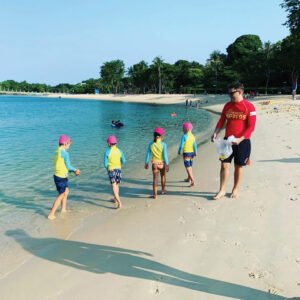
Over the years, each ANZA Nippers session has started with a beach clean-up: Age Managers and their respective age groups scour Palawan beach, picking up rubbish and disposing of it in the correct bins. It turns out to be a really fun gig as the children get excited over finding food wrappings, bottle lids, plastic and paper. The bad news is, plastic takes from 20 to 500 years to decompose (a plastic bag roughly 20 years; a bottle 450 years) and paper 4 – 6 weeks*. Sadly, despite our best efforts, a lot of the rubbish left on the sand by beachgoers ends up in the ocean.
Global hotspot
According to the United Nations, every minute, the equivalent of one rubbish truck of plastic is dumped into our oceans. Fish, seabirds, sea turtles and marine mammals can become entangled in or ingest plastic debris, causing suffocation, starvation, and drowning**.
Throughout the season, ANZA Nippers event manager Jaq invites guest speakers to our sessions – back in October, we hosted the Friends of Marine Park experts who shared their knowledge on corals and reef protection. We’re always grateful to these organisations who volunteer their time on a Sunday to educate the future generation.
What many of us don’t realise is that Singapore sits in a global hotspot of coral reef diversity. Recent surveys show that the island contains more than 255 species of coral. That is half as much as the entire Great Barrier Reef, and nearly three times as many as live in the Atlantic Ocean!
Singapore has about 600km2 of sea, with about 9.5km2 of coral reef, 6.26km2 of mangrove forest, and about 5km of mud flats. According to the Comprehensive Marine Biodiversity Survey by the National Parks Board (NParks) and the National University of Singapore, the island is home to over 1100 species, including several new ones, only discovered as the survey was being carried out.
Eco challenges
The urgent need to address environmental challenges and to develop a conservation plan was recognised when Singapore announced a broadly conceptual National Biodiversity Strategy and Action Plan (NBSAP) in 2009, followed by a holistic NParks’ Nature Conservation Master Plan (NCMP) in 2015, with the aim to chart the course of Singapore’s future biodiversity conservation efforts.
In the past decade, many organisations, associations and community groups have been initiated involving more than 40,000 volunteers, citizen scientists, nature advocacy groups, academics and others. All have the common goal to preserve Singapore’s unique and fascinating coastal and marine environment.
We can all do our part. We see it as our mission at ANZA Nippers to raise awareness, educate, and act with the aim to protect the environment and marine life for future generations to come.
 Ask an expert
Ask an expert
We spoke to Gail Tay, Director of Operations & Programmes at The International SeaKeepers Society when she was in town in November.
Tell us about the International SeaKeepers Society…
We’re a not-for-profit organisation which was founded in 1998 in the US by a small group of yacht owners who were alarmed by the state of the ocean.
What are you working on right now?
One of our science projects is “Seabed 2030” in cooperation with the Nippon Foundation. The aim is to map 80% of the world’s ocean floors by 2030. We also help grassroots communities in countries like Indonesia with projects on coral restoration.
You brought the ocean collective summit to Singapore at the end of last year…
The event was attended by around 150 people with 13 international and local speakers. The audience consisted of students from Republic Polytechnic, NTU, and the National University of Singapore, members of the marine conservation community and people from the corporate sector.
What do you hope to achieve in Asia over the next few years?
We will continue our mandate to create an awareness of the health of the ocean through educational outreach and will be launching more citizen science programmes. Our biannual song writing programme encourages young songwriters to produce songs about the ocean which are then made available through music platforms such as Spotify. Meanwhile, in Malaysia we’re working towards conserving sea turtles in Terengganu. We are mainly trying to do three things: 1) create an educational roadshow for schools to educate students about sea turtles 2) support a hatchery on Kapas island 3) habitat monitoring around Kapas island to ensure sea turtles come back and lay their eggs.
What eco message would you like to share with our Nippers?
You don’t have to be a scientist to protect the corals and the ocean. Anybody can take part and you can do it in the way you live your life on a daily basis.

VOLUNTEER HERE
If you’re interested in conservation in SG, check out the following groups:
- Guardians of Mother Earth Singapore (hiking)
- Nature Society (kayaking)
- Our Singapore Reefs (diving)
- Little Green Men (mangroves clean ups)
- Green Nudge (coastal clean ups)
- Marine Stewards (various)
Term 1 starts 5 March 2023
Registrations are now open
Visit anza.org.sg
For enquiries contact Kat at [email protected]
Follow us on @sgnippers or @SingaporeNippers
*science.howstuffworks.com, **pewtrusts.org



 Ask an expert
Ask an expert




